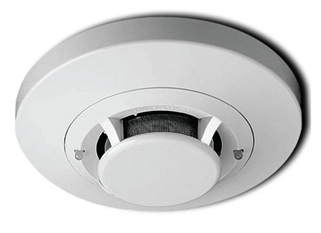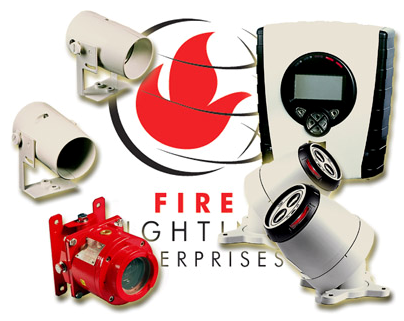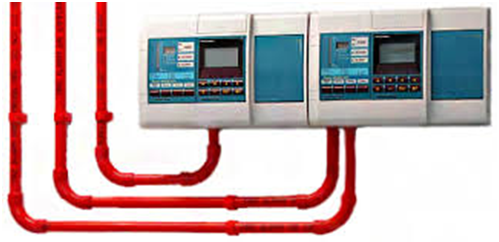There are three types of smoke detectors: ionization, photoelectric, and combination.
Ionization
 Fire alarm systems use the ionization smoke detector to a large extent. For clean-burning fires that produce small particles during combustion, the ionization smoke detector is the best choice as it can detect smoke originating from a fire.
Fire alarm systems use the ionization smoke detector to a large extent. For clean-burning fires that produce small particles during combustion, the ionization smoke detector is the best choice as it can detect smoke originating from a fire.
The ionization smoke detector consists of an alpha particle producing a radioactive source, a smoke chamber, and charged detector plates.
-
- The alpha source causes the air within the smoke chamber to become ionized and conductive.
- As smoke particles enter the smoke chamber, the smoke particles attach themselves to the ionized air molecules, and the air in the chamber becomes less conductive.
- When the air conductivity within the chamber drops below a predetermined level, the alarm is triggered.
Advantages of Ionization Smoke Detectors:
-
- Detect invisible products of combustion- They can detect fires that are in the incipient stage or detect other aerosol-type smoke products.
- Quick acting — Earlier detection than other types of smoke detectors or thermal detectors.
Disadvantages of Ionization Smoke Detectors:
-
- May provide false detection if used where volatile solvents, conductive material dusts, or high humidity are present.
- Detect the presence of smoke only, not toxicity.
- Have a potential for high false alarm rate.
Typical locations or hazards for ionization detection:
-
- Clean rooms
- Computer rooms
- Mechanical air ducts
- Locations where sensitive detection methods are needed
Photoelectric
 A photoelectric smoke detector is the most common smoke detector used today. It detects smoke by using either the principle of light obscuration or light scattering. Fires that produce large particles during combustioncan be sensed by these detectors as they can detect smoke originating from a fire.
A photoelectric smoke detector is the most common smoke detector used today. It detects smoke by using either the principle of light obscuration or light scattering. Fires that produce large particles during combustioncan be sensed by these detectors as they can detect smoke originating from a fire.
Spot type photoelectric smoke detectors using the light obscuration principle have a light emitting device, usually a light-emitting diode (LED), a smoke chamber, and a photosensitive device that receives the light directly from the light source and produces a monitored current.
Smoke that enters the smoke chamber reduces the intensity of tech light reaching the photosensitive device, which reduces the monitored current. When the intensity drops below a certain level, the sensor control circuitry detects a drop in the current produced by the photosensitive device. When the current falls below a pre-set threshold, the smoke alarm is triggered.
Spot type photoelectric smoke detectors using the light scattering principle are built the same way as detectors using the light obscuration principle except that the photosensitive device is set such that it cannot see the light source directly. When smoke enters the chamber, the smoke particles reflect the light from the source into the photosensitive receiver. When sufficient light intensity is detected, the alarm is triggered.
Advantages of Photoelectric Smoke Detectors:
-
- Sensitive to visual particles of smoke
- Detects smoldering low heat fires
- Provide early warning
Disadvantages of Photoelectric Smoke Detectors:
-
- Early contamination by dust causing reduced sensitivity
- Detects presence of smoke, not toxicity
- Must be cleaned on a regular basis
- Has a potential for high false alarm rate
Typical locations or hazards for photoelectric detection:
-
- Office areas
- Clean rooms
- Raised floor spaces
- Atriums and corridors
- Meeting rooms
- Computer rooms
- Telecommunications rooms
- Electrical equipment rooms
- Sleeping rooms
- Storage closets
Beam Detector
 Beam smoke detectors are line-type photoelectric detectors consisting a separate light source and photosensitive receiver. These devices are usually installed in large open areas that have an unobstructed line of sight between the light source and the receiver. Due to the number of spot-type detectors required, they are economically unfeasible in large spaces.
Beam smoke detectors are line-type photoelectric detectors consisting a separate light source and photosensitive receiver. These devices are usually installed in large open areas that have an unobstructed line of sight between the light source and the receiver. Due to the number of spot-type detectors required, they are economically unfeasible in large spaces.
Advantages of Beam Smoke Detectors:
-
- Cover a large area economically
- Quick acting
Disadvantages of Beam Smoke Detectors:
-
- Unobstructed LOS between the light source and the receiver
- Correct alignment needs to be maintained
Typical locations or hazards for beam detectors:
-
- High atriums
- Manufacturing spaces
Air Sampling Smoke Detectors
For environments where detection of smoke is most critical, an air-sampling system provides the earliest possible detection. An air sampling or aspirating type fire detection system is a self-contained smoke detection package comprising five primary components:
-
- Air-sampling system
- Aspiration system
- Filter assembly
- Detector
- Control system
It uses a network of pipes to continuously draw air samples and direct them to a central smoke detector.
 The system operates with a network of sampling pipes that extend into the protected area. The pipes consist of a thermoplastic material. An internal aspirator continuously draws air into the piping network. The systems use either a filter assembly or laser particle counting technology to filter out airborne dust and debris particles, which helps to eliminate false readings.
The system operates with a network of sampling pipes that extend into the protected area. The pipes consist of a thermoplastic material. An internal aspirator continuously draws air into the piping network. The systems use either a filter assembly or laser particle counting technology to filter out airborne dust and debris particles, which helps to eliminate false readings.
Typical locations or hazards for Air-Sampling smoke detectors:
-
- Telecommunications areas
- Computer rooms
- Data centers
- Hospitals
- Clean room environments
- Atriums
- Cold storage areas
- Power stations
- Mines
- Paper and timber mills
- Museums
- Art Galleries
- Cathedrals

